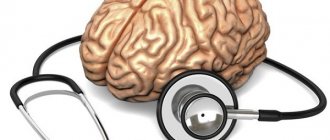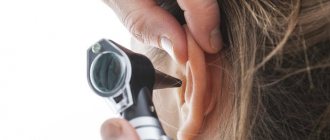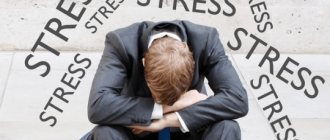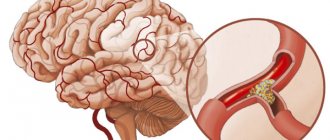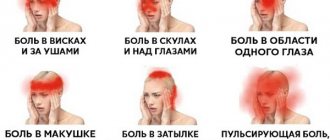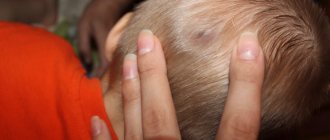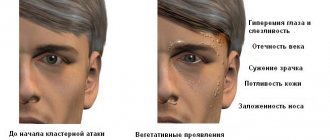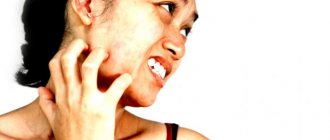The feeling as if there is a shooting in the head occurs suddenly. The pain affects individual points, and sometimes affects entire areas, preventing you from working, studying, or performing household chores. Bright light and loud sounds cause irritation and increase pain. If the pain is too severe, there is no other choice but to call an ambulance. According to ICD data, about 70% of the world's population have experienced such sensations at least once in their lives. A similar problem can affect adults and children.
Characteristic
Shooting pain in the head, or cranialgia, occurs suddenly, without any obvious trigger. It is not an idiopathic disease; it manifests itself as a sign of one or another pathology. It is characterized by the following features:
- An unexpected sudden appearance in the form of a painful impulse. The duration of the attack ranges from a couple of seconds to 10 hours. Shooting in the head is constant.
- The pain is very intense and intensifies with eye movement. It is similar to the feeling that a bell is beating in the skull; on the contrary, it can be superficial. It is impossible to touch the painful area. Painkillers don't help.
- The lumbago is localized mainly in the temporo-occipital part, sometimes radiating to the neck. When trigger points are pressed, new attacks occur.
- The pain is accompanied by vomiting. Temperature may rise to 37.5°C and nausea may occur.
- Acute pain in the cervical region, upper back.
- Feeling as if something is shooting in the ears, twitching, loud sounds cause irritation.
- Laughter, coughing, even chewing food or a woman removing makeup leads to the feeling that something is hitting or shooting inside the head.
- Numbness of the limbs. My arms and legs feel tight and ache.
- Rocking gait.
- Changes in personal qualities. A person often becomes nervous, irritable, and tense. Nothing touches him, he pays attention only to his feelings.
- With frequent occurrences, intelligence and memory suffer, sometimes the patient cannot remember the PIN code or phone numbers.
Shooting pain in the head - methods of treating cranialgia
In official medicine, lumbago or shooting pain in the head is called cranialgia. This pathological process develops against the background of disturbances in the functioning of the nervous system and the location of the nerve nodes on the head. Shooting pain syndrome is not a separate disease, but a symptom of a systemic illness.
Migraine
This pathology is accompanied by unilateral pain of a pulsating nature (on the left or right), which is combined with lumbago in the head, neck and upper back. Before the onset of a migraine, a person may experience warning signs in the form of an aura. The clinical picture becomes intense under the influence of bright lighting, odors and loud sounds.
Cluster headache
With this pathology, attacks occur in series 2-10 times a day, lasting from 15 minutes to 1 hour. This phenomenon lasts for 2-3 weeks, and then gives way to a protracted period of remission.
Cluster headaches occur suddenly and are accompanied by lumbago in the back of the head, radiating to the eyeball. This symptomatology is very painful, as a result of which the person is unable to fully engage in normal activities. Before a cluster headache occurs, a person sometimes experiences blockage in one ear.
Concussion
Shooting in the head often occurs in a person who has previously suffered an injury such as a concussion. Pain syndrome is accompanied by the following symptoms:
- nausea;
- vomiting;
- dizziness;
- momentary fainting.
As soon as the functions of the organ are restored, the unpleasant symptoms will go away on their own without treatment.
Intracranial pressure
Shooting sensations in the temples are possible with increased intracranial pressure. The nature and type of symptoms depend on the degree of influence of the cerebrospinal fluid on brain tissue. In severe cases of pathology, the following signs are possible:
- convulsions;
- dizziness;
- vomit;
- nausea.
Ear infection
The inflammatory process occurring in the hearing organs leads to lumbago in the head and damage to the temporal bone. The culprit of the pain is purulent otitis media.
Trigeminal neuralgia
With this disease, lumbago is observed mainly in one half of the skull. The duration of the attack ranges from 10 seconds to 2 minutes. Symmetrical development of the symptom is extremely rare.
Spinal disorders
The pain syndrome is formed against the background of compression of the spinal nerves. The pain is one-sided and shooting, radiating to the back of the head, temporal parts and frontal lobes. The main reasons for its development are the following diseases:
- osteochondrosis;
- intervertebral hernia;
- disc protrusion;
- cervical spondylosis.
Cervical osteochondrosis
This disease is characterized by shooting headaches in the crown and back of the head. Patients complain of a crunching sound that occurs when turning their head, and numbness in their fingers. The intensity of the clinical picture increases at the end of the day or after prolonged exposure to an uncomfortable position.
Arthrosis
With this disease, the cartilage in the area of the intermaxillary joint becomes thinner, which can lead to a decrease in the functionality of the formation. Arthrosis at the initial stage of development leads to the development of symptoms such as clicking and rusting when moving the lower jaw. As soon as the pathological process has moved to a new level, the patient experiences more serious symptoms:
- when eating or talking, pain radiates to the head;
- hearing decreases;
- the jaw apparatus becomes numb;
- the face becomes asymmetrical.
Arthritis
This disease is characterized by dysfunction of the temporomandibular joint. In this case, the patient experiences pain similar to a migraine. Elderly people may suffer from temporal arthritis, which is characterized by inflammation of blood vessels, aneurysm of the carotid artery, causing lumbago in the temples and back of the head.
Tumor
When a tumor forms and grows, shooting pain in the head occurs intermittently or becomes permanent. It worries a person due to compression of tissues by the tumor. If the neoplasm is cancerous, then the toxins released by the conglomerate have a negative effect.
Calcium salt metabolism disorder
Failure in metabolic processes affects the formation of salt deposits in the joints and parts of the spine. This reduces the performance of systems and provokes the development of inflammatory processes. The patient complains of lumbago in the affected areas and head.
Diagnosis of cranialgia
To eliminate a shooting headache, it is necessary to determine what led to its development. First, you need to visit a therapist, who, after examination and tests, will refer you for a consultation to specialists of a narrow profile:
- ENT doctor. He will assess the condition of the hearing organs and examine the nasal cavity to exclude infectious diseases.
- Vertebrologist. He checks the condition of the spine to exclude cervical osteochondrosis.
- Neurologist. The doctor performs a brain examination to rule out dangerous diseases and inflammations.
If one of the above pathological processes was detected, the patient will need to undergo head and cervical diagnostics:
Pills
Acute diseases accompanied by severe pain must be treated in a hospital. If the cause of cranialgia is a bacterial infection, then the following drugs are effective:
- Antibiotics: Ampiox, Ceftriaxone, Zitrox. They can be prescribed in the form of tablets or injections.
- Anti-inflammatory medications: Indomethacin, Ibuprofen, Diclofenac.
- Combined medicines with analgesic effects: Spasgo, Spasmalgon.
- Vitamin B complex in the form of injections.
If lumbago in the head is caused by neuritis and muscle tension, then the following remedies are effective:
- Nootropic and neuroprotective medications in the form of injections and tablets: Actovegin, Thiocetam, Cortexin, Piracetam.
- Tranquilizers: Tozepam, Phenazepam.
To treat osteochondrosis, ointments containing non-steroidal components are included in the therapy:
- Fastum Gel;
- Diklak;
- Finalgon.
Exercise therapy
Simple physical exercises for the spine are indicated for eliminating the causes of the development of lumbago in the head and their prevention. All procedures are aimed at strengthening the muscle corset, improving posture, and normalizing blood flow in the cervical spine. A set of exercises is prescribed by a doctor, but in practice the following are most often used:
- Take a horizontal position, legs straight, arms along the body. Raise your head and remain in this position for 3-7 seconds. Repeat exercises 1-3 times.
- Place your hands on your shoulders and perform circular movements in one direction and then in the other direction 4 times. Repeat the exercises 2-3 times.
- Place your arms along your body, clasp your legs at the knees, and begin walking in a lying position. Perform for 30 seconds, do 2-4 repetitions.
- Place your arms along your body, then inhale and move them upward through your sides, while exhaling, pull your knees to your chest without lifting your head. Repeat exercises 4-6 times.
Massage
With the help of massage, you can work on soft tissues in superficial pathological processes. Thanks to the targeted effect on biologically active areas, it is possible to quickly relieve pain.
To get maximum results, you need to use your fingertips to massage the brow ridges, the line between the eyebrows from the bridge of the nose to the place of hair growth, as well as the temples. Stroking the top of the head will help to consolidate the massage if you move towards the neck.
Essential oils will help enhance the effect of the procedure:
- sandalwood;
- lavender;
- rosewood.
Physiotherapy
Physiotherapy is effective for shooting pain in the head. In inpatient settings, the following procedures are prescribed:
- electrophoresis;
- UHF;
- galvanic current;
- magnetotherapy.
At home, with the permission of a doctor, warm compresses and warm baths are allowed. According to indications, the doctor may prescribe acupuncture.
Prevention
To prevent lumbago in the head, you must follow simple rules that will not allow pain to develop:
- Head massage or exercise.
- Ventilate the room more often to prevent problems with blood vessels.
- Strong odors that lead to lumbago for no reason are undesirable.
- Review your diet, add fresh fruits and vegetables.
Cranialgia is a dangerous symptom that can signal a serious pathology. Only modern diagnostics and treatment will prevent the occurrence of severe complications, and adherence to prevention is an excellent guarantee of the development of unpleasant symptoms.
Source: https://HeadHealth.ru/prostrel-v-golove.html
Causes
The occurrence of shooting pain is caused by various disorders.
Spinal pathologies such as osteochondrosis, intervertebral hernia, protrusion, cervical spondylosis, and injuries lead to compression of the roots of the spinal nerve fiber and, ultimately, to the appearance of pain.
With neuritis of the trigeminal nerve, post-traumatic neuralgia, damage to the glossopharyngeal processes, toxic polyneuropathy, damage or compression of the peripheral processes occurs. The pain is localized at the site of the lesion. It is impulsive in nature. Lasts from 2 seconds to several minutes.
When pathologies such as an aneurysm, hematoma, cyst, malignant tumors, osteomyelitis of the jaw, or traumatic brain injury occur near the autonomic ganglia, compression and inflammation of the nerve fibers occurs.
Painful sensations also appear under the influence of infectious disorders of the organs of hearing and smell, such as purulent otitis media, sinusitis, and sinusitis.
Diagnosis of cranialgia
A professional examination by a medical specialist is the first step to determining the cause of lumbago in the head. Further diagnostic measures are prescribed based on the results of the preliminary examination and survey. It is possible that to continue the examination and clarify the diagnosis, you will need to consult such specialists as a neurologist, vertebrologist, rheumatologist, otolaryngologist, endocrinologist, and others.
Modern medicine has a sufficient number of diagnostic methods to identify the cause of lumbago in the head. Laboratory and instrumental research methods are assumed.
Laboratory tests usually include blood and urine tests.
Suspicion of pain due to pathological processes developing in the ENT organs requires the use of instruments specially designed for examining them.
Hardware diagnostics has a wider range of methods. For any type of pain that occurs in the head, and especially with a sharp shooting pain, it is suggested to examine the head using ultrasound, that is, ultrasound examination, as well as CT, that is, computed tomography. In many cases, they resort to MRI examination, that is, magnetic resonance imaging. A more common method is x-ray examination. A method such as Doppler sonography can be used to determine the condition of the blood vessels.
In order to more accurately determine the cause of attacks of sharp, shooting pain in the head, an examination will have to be carried out not only in the head area, but also in the cervical spine.
Localization
Usually the pain is one-sided, shooting in the head on the right or left side in any area.
- Frontal pain occurs mainly in the right hemisphere as a result of damage to the facial or trigeminal processes. Occurs most often after exposure to a draft or hypothermia. Appears involuntarily or as a result of pressure on a point located above the eyebrow.
- It shoots through the head in the temporal zone, usually as a result of damage to the artery of the same name, the temporomandibular joint, the trigeminal process, or osteochondrosis. Less commonly appears in the left temple area. The pain occurs spontaneously and is not associated with hypothermia or drafts. May strike with a light touch. In some cases, if you press on the painful point, it goes away. Often accompanied by nausea and dizziness. It haunts the patient even at night, preventing him from falling asleep. Doesn't respond well to medications.
- The pain is felt in the parietal region, can arise and disappear unexpectedly, and develop into an attack that lasts a long time. This is due to the fact that various nerve endings are located in this area. The causes are pathologies of the cervical regions of the spine.
- The feeling that there is a shooting in the back of the head occurs when the occipital nerve processes are damaged after walking in a draft, with osteochondrosis, injuries to the cervical vertebrae, hypothermia, or an uncomfortable sleeping position. The pain intensifies and seems to jerk when turning or bending. It can be bilateral and can move to the neck area, to the shoulders, and be reflected in the ear.
- Due to damage to the trigeminal branch, pain appears in the middle and bottom of the face, or shoots in the head on the left or right side. In severe cases, it is accompanied by numbness of some facial areas in the area of damage to nerve fibers, insomnia, and neuroses.
- Internal shooting pain appears within the lesion of the nerve fiber leading to the nose and ear. If it shoots only behind the ear, suspicion falls on damage to the local lymph nodes. In some cases, such pain is transferred to the back of the head.
Shooting pain in the head on the left side
Any person has had a headache at least once in their life, and sometimes this feeling is very unusual and strange.
Pain in the head may not be throughout the entire area, but only on a certain side. In some cases, it hurts in the temporal part or forehead.
It can also be different in nature and often there is a shooting pain in the left side of the head.
Many people have not encountered such a symptom, but there is no reason to panic, the main thing is to determine the real reasons.
Doctors can accurately determine the cause of pain, as well as establish the correct diagnosis, after which effective treatment is carried out.
If the pain occurs on the left side of the head, then most often it appears suddenly, and in itself it is strong.
Particular attention should be paid to the fact that if discomfort occurs constantly, this symptom can become chronic.
In this regard, at the first appearance of pain in the head, you should immediately contact a doctor.
Main reasons
In medical practice, there are quite a few reasons why shooting pain begins to appear on the left side of the head.
In order not to list all types of reasons, we can highlight only the most basic of them:
- Frequent stress and emotional tension.
- Alcohol abuse, smoking.
- Drafts.
Often, shooting pain appears in the head due to constant stressful situations, when the nervous system becomes tense and excited.
Since a person has nerves throughout the body, pain in the head may not be associated with brain diseases, as many people believe.
Often, pain in the head on the left side appears due to a malfunction of certain organs in the body, so it is important to listen to the body and identify additional symptoms.
In some cases, a sharp headache on the left side is caused by wind blowing.
In addition, for this reason, discomfort can appear not only on the left, but also on the right side.
Often people cannot determine the exact location of the pain, and the doctor can only indicate the side where the shooting pain appears.
As soon as it starts shooting on one side, this indicates the development of diseases.
In this regard, it is important to determine the exact location. If the symptom occurs on the left side, then the reason is the blowing of the head.
You can blow your head at any time of the year, even if it’s warm outside and there’s no frost.
This condition most often begins in the warm season, for example, in the summer or as soon as the sun begins to appear, after winter.
People always believe that as soon as it gets warm, they won't get sick.
But as soon as a person’s vigilance is lost, his health can be significantly impaired.
In summer and spring, many people begin to walk without hats and scarves, clothing becomes lighter, but the winds can be quite cold.
When a person has a hot body, everyone wants to get a little cool, which is why illnesses and colds begin to appear. The human head is at particular risk.
During the cold season, there is a disturbance in the human immune system; a decrease in its protective functions leads to the development of a favorable environment for bacteria and viruses. The vital activity of which leads to poor health of a person, including pain.
There may be a shooting pain in the head. Head pain can be not only in the ear area, but also in the frontal part or temples.
Often the pain begins to radiate to the back of the head, as well as the cervical spine and jaw.
Another common cause is drafts in an apartment or house.
This problem arises with the onset of warm weather, especially if there is still heating in the house, and it is already quite warm outside the window.
In this case, people open the windows and a cold draft appears.
Drafts have a greater effect on the back of a person's head on the left side of the head. Shooting pain appears after turning the head to the sides, after which sharp sensations appear.
Localization of pain
Even if an unpleasant sensation appears on one side of the head, the doctor must accurately indicate the location, which is quite difficult to determine.
If this is not detected, then the pain in the head can become chronic.
According to localization, pain on the left side of the head can be as follows:
- In the frontal region. As a rule, a person experiences discomfort for no reason and quite sharply, above the eyebrow area. Patients often suffer from drafts, and the discomfort increases with the slightest physical exertion.
- In the temporal region. On the left, the symptom rarely appears, but it may be that the sensations become stronger if you press on the temples. This condition is provoked by osteochondrosis and is not accompanied by other symptoms such as vomiting or nausea, as with migraine. During sleep, the sensations do not go away, and it becomes difficult to fall asleep, which causes disruption of normal sleep.
- In the crown area. Discomfort occurs quickly and very often. In this area of the head on the left side there are many nerves, due to the high pressure a shooting pain begins.
- In the back of the head. In this part, a person experiences seizures when quickly bending over or turning his head. In addition, the syndrome can be not only on the left, but also on the right. If you touch the back of the head, the lumbago becomes stronger. Such attacks are often localized behind the ears, but can spread to the entire back of the head or neck. The problem appears as a result of being in one position for a long time, as well as from a draft.
In some cases, the left side may shoot as a result of teeth that hurt.
In this case, the syndrome only becomes stronger if you start eating anything or just lying down.
Another possible cause of lumbago could be otitis media and other inflammatory processes in the ears.
Inflammation can radiate to any part of the head, especially to the forehead and back of the head.
Drug treatment
If the left side of the head begins to shoot suddenly and sharply, and the sensations are very pronounced, then therapy should be carried out in a hospital setting, exclusively in an inpatient setting.
The patient may be prescribed the following medications:
- Antibacterial drugs. Such strong drugs can be used in case of infection of the body with bacteria that provoke pain in the head on the left. For therapy, you can use medications called Zitrox or Ceftriaxone. The drug can be prescribed in tablet form or as injections.
- Combined means. Such treatment can be prescribed to eliminate pain, and “Spazmalgon” is often used for this.
- Anti-inflammatory drugs. These are drugs from the non-steroidal group, these include Ibuprofen, as well as Indomethacin.
- Vitamins. Additionally, vitamin complexes based on vitamin B are prescribed for therapy.
- Nootropics and neuroprotectors can be used to reduce headache pain. These include Actovegin and Piracetam.
- Tranquilizers. On the left side of the head, pain is relieved with the help of Phenazepam.
- Local medicines. Topical products can help reduce head discomfort. They are very effective for osteochondrosis and you can use Fastum Gel or Finalgon for treatment.
In some cases, pain can be relieved using conservative methods.
For this you can use:
- Physiotherapy. This method includes the use of galvanic current, UHF, electrophoresis, and laser therapy.
- Perhaps a regular massage or manual therapy will ease the condition. Such methods will normalize blood circulation and also improve the absorption of beneficial elements into the tissue. You can do the massage yourself and relieve pain well if you do it 4-5 times a day. Massage is useful if the pain is superficial. The remaining procedures should be carried out only with the help of a specialist.
- Water procedures, for example, water massage or shower, have a good effect.
- Treatment is carried out using heat. For this, it is possible to use paraffin if the procedure is carried out in a hospital setting. Headache can be relieved at home with dry heat. This technique helps with neuritis and neuralgia for any part of the head. Heat must be used carefully as it may not be suitable for all people.
- In the most difficult cases, doctors use novocaine blockade.
To quickly eliminate pain, you need to consult a doctor as soon as it appears in your head and becomes stronger every hour.
In addition, you will need to undergo a diagnosis if the symptoms do not go away within several days and are not relieved by painkillers.
Home treatments
If you don’t shoot in the head area very often, and the causes of this condition are known, and they do not pose a threat to health, then you can do the therapy yourself, at home.
When using tablets, you should give preference only to those drugs prescribed by the doctor and use them in the exact dosage.
As soon as the syndromes appear, the patient must be given complete rest. To do this, you can turn off the TV and music so that there is silence in the room.
In addition, it is recommended to dim or turn off the lights and close the doors to prevent drafts.
You can open the window slightly to bring in fresh air.
At home, you can get rid of headaches using the following methods:
- Aromatherapy. To do this, just do an inhalation or pour a little essential oil on a handkerchief and tie it to your neck. For therapy, it is recommended to use eucalyptus oil, clove oil, and lemon oil. Tea tree will also help.
- Compress. A dry compress is used to relieve pain. To prepare, heat the salt in a frying pan and put it in a handkerchief, then apply heat to the place where there is pain. For a compress, you can use Dimexide and Novocain.
To prevent unpleasant symptoms from occurring, it is recommended to prevent them, as well as timely treatment of viral and infectious infections of the body.
You should also try not to stay in cold or drafts for a long time.
If the pathological condition is correctly diagnosed, you can quickly recover without complications.
Source: https://1golovabolit.ru/bolit-golova/strelyayushhaya-bol-v-golove-s-levoj-storony.html
Diagnostics
The appearance of impulsive shooting pains can be associated with various factors, and if they are not detected and the necessary measures are not taken, the patient’s condition can rapidly deteriorate. Therefore, at the first occurrence of such pain, you should consult a therapist. He will clarify the characteristic features of pain, location, additional signs, and conditions of occurrence. Depending on the symptoms, he will give you a referral to visit a specialist in order to determine exactly why the pain occurred.
The otolaryngologist will conduct a thorough examination of the nasal cavity and hearing organs for the presence of sinusitis, sinusitis, and otitis media.
The neurologist will clarify the symptoms and check the reflexes. Prescribes a brain examination to exclude tumors, including malignant ones, cysts, and hematomas.
Shooting pain in the head on the right side: causes, diagnosis and treatment methods
Shooting pain in the head is a symptom that often occurs in patients with various pathological processes. This manifestation cannot be considered as a separate disease. Therefore, if a symptom occurs, you should consult a doctor and undergo an examination. This will allow you to establish a diagnosis and prescribe appropriate treatment.
The nature of sensations and their localization
Shooting headaches are paroxysmal episodes of unpleasant sensations that can be located on both the left and right sides of the head. The pain can radiate to other areas - neck, shoulders, or eye sockets.
More often the symptom is acute, occurs suddenly or is provoked by various external stimuli. However, the pain can also be chronic. This condition is manifested by prolonged attacks of 10 hours or more, during which discomfort in the head persists constantly and significantly worsens the patient’s quality of life.
Associated symptoms
In addition to the shooting headache, the patient may experience other characteristic symptoms, based on the spectrum of which doctors assume the diagnosis of the patient.
Useful information Most often, discomfort in the head is accompanied by nausea, dizziness and vomiting. These are nonspecific symptoms that indicate a general disturbance in brain activity.
Such manifestations are typical for migraines, neuralgia, and concussions.
Nonspecific manifestations also include numbness of the extremities, indicating a pathology of the peripheral nervous system. The presence of articular disorders in the spine is indicated by severe pain in the neck combined with a crunching sound when turning the head. Sometimes patients may experience impaired mobility in the cervical spine; any movement is impossible due to contracture and arthritis.
In the presence of peripheral inflammation, the patient experiences corresponding symptoms. If the cause of the development of the clinical picture is otitis media, then there will be decreased hearing and severe pain in the ear canal.
In the case of pulpitis and other dental diseases, the patient experiences severe toothache; other symptoms include increased sensitivity to thermal influences, bleeding gums, etc.
d.
In more severe brain pathologies (tumors, cysts, injuries), headaches are accompanied by a sharp deterioration in the condition of the nervous system, which can manifest itself as the following symptoms:
- Eye symptoms (nystagmus, strabismus, gaze paralysis);
- Violation of facial expressions, spasm of masticatory muscles;
- Convulsions;
- Paresis and paralysis of the limbs;
- Breathing disorders;
- Decreased coordination of movements, changes in gait, inability to make precise muscle movements.
The listed disorders indicate severe damage to the nervous system. When they appear, it is necessary to urgently hospitalize the patient in order to stop the disease before severe irreversible complications develop.
Diagnostics
The initial appointment of a patient with headaches is carried out by a general practitioner. He asks the visitor about when the pain began, how often episodes occur, where the discomfort is localized and where it is sent. The patient needs to remember what provokes the symptoms or increases their severity. This is important for establishing the nature of the pain.
After the initial examination and examination, the therapist decides on further tactics for managing the patient.
If there are signs of damage to the nervous system, the patient is referred to a neurologist, who conducts additional tests.
If the patient has a shooting pain in the head caused by otitis media, pulpitis and other disorders outside the nervous system, then he is referred to specialized specialists (otolaryngologist or dentist).
An examination of a patient by a neurologist begins with checking reflexes, assessing sensitivity, and identifying eye symptoms. The specialist collects data on the patient’s condition and prescribes additional tests - MRI of the brain, cerebrospinal fluid examination, X-ray of the spine, studies of the blood vessels of the neck and head.
Based on the results of the examination, a complete clinical diagnosis is established, according to which further treatment will be carried out.
First aid
If a patient experiences a shooting headache, the attack can be relieved with some simple methods:
- Apply a hot compress to the head - this will reduce the severity of neuralgia;
- Take painkillers – conventional analgesics usually relieve migraine episodes, tension pain and other mild attacks;
- Acupressure massage of the occipital region and neck is very effective in the presence of cervical migraine and spinal pathologies.
It is important to understand that all these manipulations only relieve the symptoms of the disease without affecting the cause of its occurrence. If pain occurs frequently, the patient should definitely consult a doctor about specialized treatment.
Treatment
Depending on the origin of the shooting pain, various techniques can be used to treat it, each of which has its own indications. It is recommended to use complex therapy, which has a multifaceted effect on the disease, reducing its activity and preventing the occurrence of new pain episodes.
Drugs
Most often, classical analgesics are used to relieve pain, among which Ketorol, Ketanov, Dexalgin, and Indomethacin are the most effective. The choice of drug is made by the doctor based on the characteristics of the patient’s condition and the presence of concomitant diseases.
Another method of drug pain relief is blockade, which involves the administration of local anesthetics subcutaneously to reduce the severity of pain.
This method is often used to eliminate neuralgia. To carry it out, drugs such as Novocaine, Lidocaine, Anestezin are used.
Injections are made at specific pain points - usually under the jaw joint, in the area behind the ear or near the brow ridge.
To improve the condition of the nervous system, additional drugs are prescribed that increase the patient’s adaptation and restore brain activity. These include nootropics, adaptogens, and B vitamins. Medicines of this kind are considered an additional method of drug therapy.
Physiotherapy
Therapeutic exercises, like physiotherapy, are indicated for pathologies of the spine, as well as for cervical migraine.
Regular performance of special sets of exercises allows patients to quickly relieve headaches and relieve other unpleasant symptoms.
In addition, the use of physical therapy can slow down the progression of the pathological process and restore normal mobility of the spine.
Important information Therapeutic exercises must be performed according to a strictly established algorithm proposed by the patient’s doctor.
This is due to the fact that the patient himself cannot adequately calculate the load on the joints, and overexertion can lead to aggravation of the pathological process.
Therefore, if severe pain occurs during exercises, you should stop doing gymnastics, after which you should consult your doctor about it.
Treatment
The main principle of therapy is pain relief and elimination of the underlying pathology. All therapeutic measures are prescribed only by a doctor based on the established diagnosis. Self-treatment is not allowed. Without deep knowledge of the anatomy and basic functions of the nervous system and musculoskeletal system, you can harm yourself.
First aid
At home, if professional help is not available, you can relieve pain as follows:
- perform a light massage on the side of the forehead, on the bridge of the nose using essential oils of clove, eucalyptus or “Star” balm;
- apply a dry compress of table salt heated in a frying pan to the painful point for 15 minutes;
- prepare inhalations with lemon, tea tree, eucalyptus or lemon oils;
- make a compress from 1 share of Dimexidine and 1 share of Novocaine;
- Apply a warm hard-boiled egg to the affected area.
Drug therapy
In most cases, if constant or prolonged shooting pain occurs, the patient is placed in a hospital under the constant supervision of a doctor.
If the pain is caused by neuritis or muscle spasms, the patient receives nootropic drugs in the form of injections or tablets. Cortexin, Actovegin, Piracetam or Thiocetam are prescribed. In addition, tranquilizers are used to relieve fears and anxiety, for example, Phenazepam or Tazepam.
If the pain is of an infectious nature, antibacterial drugs such as Ampiox, Zitrox or Ceftriaxone are prescribed in tablet form or by injection. Be sure to include non-steroidal anti-inflammatory drugs - Diclofenac, Indomethacin, Ibuprofen and vitamin B complex, which strengthens the nervous system. The doctor prescribes anti-inflammatory drugs that can also relieve pain - Spazmalgon, Spazgan, Spazgo.
Osteochondrosis is treated using non-steroidal ointments. They use Fastum Gel, Finalgon, Capsicam, Diclak. Rumalon injections are administered to restore cartilage tissue.
Physiotherapy
Medication methods are complemented by physiotherapy.
Electrophoresis acts directly on problem areas. A direct electric current is given in combination with the administration of drugs. This relieves swelling and pain, relaxes muscles, and calms. The main share of the administered drug is initially retained in the skin and subcutaneous areas and only after a day enters the blood. The delayed effect allows for a long-term effect of the medication. Under the influence of current, burning and tingling may occur.
The basic principle of UHF operation is the electromagnetic fields of ultra-high frequency waves. The painful point is exposed to heat. This relieves swelling and reduces pain intensity. UHF also has an anti-inflammatory effect.
Magnetic therapy involves exposing the affected area to magnetic fields. It relieves pain and swelling, soothes and relaxes. However, this method is not prescribed for tumors, pregnancy, or if the patient has high blood pressure.
Laser therapy uses infrared and red rays. Infrared penetrate to a depth of soft tissue up to 8 cm, bone - 1.2 cm. The penetration depth of red is 2 mm. Radiation reduces pain, has an anti-inflammatory effect, and improves blood circulation. The impact is on the inflamed area, individual areas of the spine or nerve bundle.
An indispensable method used for shooting pain is massage. The effect is used on the cervical region, as well as on special points of the head located at the back, sides, and crown. Spinal massage is performed only by a specialist. Acupressure is available to the patient himself. Up to 2-3 times a day, you can easily massage the brow ridges, the conventional line from above from the border of the forehead to the bridge of the nose and from it to the side.
A circular shower is essentially a type of massage. Jets of water affect the skin, subcutaneous tissue, and muscle tissue.
For spinal lesions, special physical exercises are recommended. Their complex, frequency, duration are determined only by a doctor. Exercise therapy is aimed at strengthening the muscle corset, restoring posture and normal blood flow.
ethnoscience
On the recommendation of a doctor, you can use traditional methods.
At night, you can prepare a compress from geranium leaves. To do this, add 250 ml of water to a few leaves and cook in a water bath for half an hour. Dip a piece of gauze into the resulting broth and then apply it to the painful area.
Grate the horseradish root, wrap it in gauze and put it where it hurts. This compress can also be left overnight. In the morning, make sure that the sore spot is not exposed to wind or cold.
Peppermint decoctions are prepared for internal use. Pour boiling water over a tablespoon of pre-crushed plant and leave for one hour in a warm place. You can add honey to the decoction. Drink a glass of decoction 2-3 times. It also helps well with sore throat, pharyngitis, other throat diseases, flu, neuroses, and insomnia.
Basic therapy methods
A large number of pathological conditions that provoke the occurrence of painful attacks require a selective approach to their elimination:
- Diseases associated with inflammation of the hearing organ. For otitis media, which is the most common cause of lumbago in the head, it is advisable to use antibacterial and anti-inflammatory medications. The best anti-inflammatory drops are Otinum and Otipax. If taking antibiotics (Amoxicillin or Biseptol) does not give positive dynamics, it becomes necessary to remove purulent foci surgically. As additional means to prevent the development of swelling and blockage of the Eustachian canals due to infectious diseases of the nasopharynx, the use of nasal drops Naphthyzin, Nazol, Galazolin is recommended.
- Backache caused by cervical osteochondrosis becomes an indication for the use of non-steroidal anti-inflammatory drugs - Dexalgin, Ibuprofen, Indomethacin or Diclofenac. A good effect can be seen with the use of external ointments in this category. The best of them are Fastum-gel, Diklak, Capsicam.
- Sulfur plugs. They can be easily removed with hydrogen peroxide or drops of A-Cerumen or Remo-Vax.
- Inflammation of the trigeminal nerve. Shoots are constant companions of this pathology. A positive effect is achieved by using the anticonvulsant - Carbomazelin. An integrated approach to treatment involves a course of physiotherapy sessions. The patient is prescribed painkillers novocaine blockades and vitamin B injections.
- Respiratory diseases of bacterial etiology require the use of antibiotics such as Ampiox, Ceftriaxok or Ampicillin.
- For pathologies associated with disorders of the vascular system, constant use of nootropic drugs and neuroprotectors is recommended. High efficiency in eliminating negative symptoms is observed when using Cerobrolysin, Piracetam, Mildronate.
In addition to these groups of medications, the following drugs are prescribed:
- combination medications that have antispasmodic and analgesic effects - Spazmalgon, Combispasm or Spazgan;
- vitamin complexes, the best representatives of which are Milgamma and Vitaxon;
- complex treatment involves the prescription of antiepileptic drugs - Gabapentin, Finlepsin, Carbamazepine;
- From the group of tranquilizers, it is recommended to take Phenazipam, Tazepam, Gidazepam;
The choice of medications, dosage and frequency of administration is the prerogative of competent specialists. Their independent use causes side effects and significant deterioration of the condition. The list of medications is provided for informational purposes only.
Prevention
The use of certain preventive measures will reduce the intensity, reduce the frequency of painful manifestations, and eliminate the need for constant treatment:
- You need to take a break from any activity for a few minutes to do a light massage or exercise.
- Living spaces and workplaces should be regularly ventilated.
- It is important to follow the principles of proper nutrition, eat vegetables and fruits.
- In cold weather, try to avoid hypothermia, make sure that there is no air in the ears and neck area, and avoid colds.
Shooting pains are not an independent pathology. A thorough diagnosis will allow the doctor to identify what prompted its appearance and determine treatment tactics. With self-treatment, there is a high probability of developing complications. Simple preventive measures will help avoid shooting headaches.
